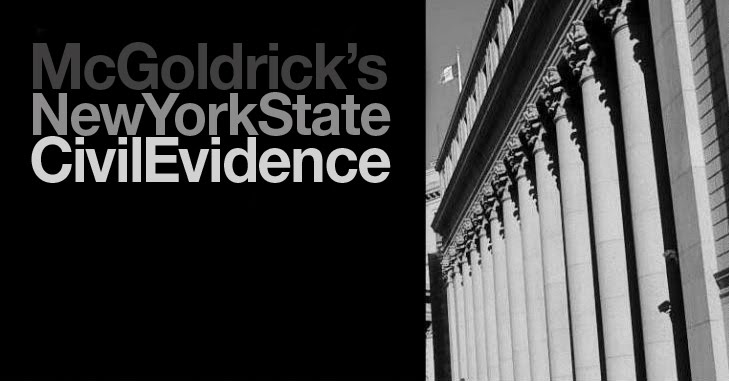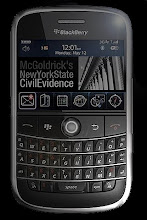In addition to being an example of how CPLR 2106 is applied to allow otherwise inadmissible expert evidence, this decision is instructive with respect to the use of police accident reports and photographs in such cases.
On the plaintiff's standard of proof:
In order to satisfy the statutory threshold, the plaintiff must submit competent objective medical evidence of his or her injuries, based on the performance of objective tests (Grossman v Wright, 268 AD2d 79, 707 NYS2d 233 [2d Dept 2000]; Lopez v Senatore, 65 NY2d 1017, 1019 [1985]). Subjective complaints alone are insufficient to establish a prima facie case of a serious injury (Gaddy v Eyler, 79 NY2d 955, 957 [1992]; Scheer v Koubek, 70 NY2d 678, 679 [1987]).
On onus:
The defendants bear the initial burden of establishing the absence of a serious injury by tendering evidentiary proof in admissible form eliminating any material issues of fact from the case (Toure v Avis Rent A Car Sys., supra; see also Gaddy v Eyler, supra; Pirrelli v Long Is. R.R., 226 AD2d 166, 641 NYS2d 240 [1st Dept 1996]). Defendant may rely either on the sworn or affirmed statements of their examining physician, plaintiff's deposition testimony and plaintiff's unsworn physician's records (Newton v Drayton, 305 AD2d 303, 760 NYS2d 38 [1st Dept 2003]; Fragale v Geiger, 288 AD2d 431, 733 NYS2d 901 [2d Dept 2001]; Pagano v Kingsbury, 182 AD2d 268, 587 NYS2d 56 [2d Dept 1992]).
But, the Courts have unanimously held that a party may not use an unsworn medical report prepared by the party's own physician on a motion for summary judgment (see Grasso v Angerami, 79 NY2d 813 [1991]; Offman v Singh, 27 AD3d 284, 813 NYS2d 56 [1st Dept 2006]). Moreover, CPLR § 2106 requires a physician's statement be affirmed (or sworn) to be [*4]true under the penalties of perjury. An affirmed physician's report demonstrating that plaintiff was not suffering from any disability or consequential injury resulting from the accident is sufficient to satisfy a defendant's burden of proof (see Gaddy v Eyler, supra).
The court found that the defendants had met their burden and proved that the plaintiff had not suffered a "serious injury":
Once a defendant has made such a showing, the burden shifts to the plaintiff to come forward with prima facie evidence, in admissible form, to rebut the presumption that there is no issue of fact as to the threshold question (see Pommells v Perez, 4 NY3d 566 [2005]; Gaddy v Eyler, supra; Perez v Rodriguez, supra). A medical affirmation or affidavit based on a physician's own examination, tests, and review of the record, can support the existence and extent of a plaintiff's serious injury (O'Sullivan v Atrium Bus Co., 246 AD2d 418, 688 NYS2d 167 [1st Dept 1998]).
Despite the critical evidence in the MRI reports being neither sworn nor affirmed, it was held admissible under CPLR 2106, eventually leading the plaintiff to successfully resist the CPLR 3212 motion:
CPLR 2106
Affirmation of truth of statement by attorney, physician, osteopath or dentist
The statement of an attorney admitted to practice in the courts of the state, or of a physician, osteopath or dentist, authorized by law to practice in the state, who is not a party to an action, when subscribed and affirmed by him to be true under the penalties of perjury, may be served or filed in the action in lieu of and with the same force and effect as an affidavit
Dr. Waxman's December 8, 2006 MRI lumbar and cervical spine medical reports are unaffirmed and unsworn and would usually be inadmissible in this motion (see Grasso v Angerami, supra; Offman v Singh, supra; CPLR § 2106.) However, they are admissible evidence here, because Dr. Waxman's MRI medical records were properly referenced and reviewed by defendants' medical expert (Dr. Feuer[FN2]) in his medical affirmation (see Pommells v Perez, 4 NY3d 566, 577, n 5 [2005]; Navedo v Jaime, 32 AD3d 788, 822 NYS2d 43, [1st Dept 2004]; Brown v Achy, 9 AD3d 30, 776 NYS2d 56 [1st Dept 2004]; Gonzalez v Vasquez, 301 AD2d 438, 754 NYS2d 7 [1st Dept 2003]; Ayzen v Melendez, 299 AD2d 381, 749 NYS2d 443 [1st Dept 2002]). Angel's physician, Dr. Boppana, stated in his medical affirmation that he reviewed the [*6]plaintiff's MRI films[FN3] and incorporated their results in his conclusions.
Dr. Waxman's MRI reports indicated that plaintiff suffered a broad based disc herniation at L4-L5 with left foraminal stenosis and a disc bulge at L3-L4 with anterior thecal sac effacement, and multilevel disc bulging from C3-C4 through C6-C7 with ventral epidural space effacement.
...
Here, though the evidence presented by Angel does not rebut defendants' proof that he did not suffer serious injury under the Insurance Law § 5102 (d) categorizations of a permanent loss of use of a body organ, member, function, or system; a permanent consequential limitation of use of a body function or system; or the 90/180-day category, the objective criteria and their norms as presented in Dr. Boppana's medical affirmation has raised material issues of fact as to whether or not Angel sustained injuries under the Insurance Law § 5102 (d) category of a significant limitation of use of a body function or system category (see Pommells v Perez at 577).
The defendants also moved for summary judgment on liability, and sought to lead photographs alleged to have been taken by another of the defendant bus company's employees. That attempt was not successful, despite attempts by counsel to affirm the photographs:
The defendants also offer prime facie photographs allegedly taken after the accident by another bus driver employed by the defendant Amboy Bus Company who was just passing by the accident (see Notice of Motion, Exhibit I, Affirmation in Opposition, Exhibit 4). This unidentified bus driver allegedly named "Carmen" is never properly identified, deposed nor submitted an affidavit to authenticate the photographs. Moreover, the defendant Davis when asked about the photographs he replied that he never saw the photos and was unaware how were taken (id., Exhibit G, at 35-36):
The Court holds these photographs are inadmissible on this motion. We rely upon the Appellate Division, First Department's recent holding in Coleman v Maclas, 61 AD3d 569, 2009 NY Slip Op. 03100 [ 1st Dept. April 23, 2009]. The Court affirmed that "the [trial] court properly disregarded the uncertified police reports and unauthenticated photographs as they were inadmissible hearsay (see Figueroa v Luna, 281 AD2d 204, 206, 721 NYS2d 635 [2001] )." The Court held "Further, the affirmation by plaintiff's counsel, who had no personal knowledge of the accident, was not admissible evidence... (see Johnson v Phillips, 261 AD2d 269, 270-271, 690 NYS2d 545 [1999] )." [*8]
The defendants further sought to lead a police accident report, without calling either the police officer who had authored that report, or who had witnessed the immediate aftermath of the accident and witnessed spontaneous statements or declarations against interest made by persons who witness or who were involved in the accident. That attempt by the defendants to introduce the contents of the police accident report failed:
In addition, defendants (uncertified) copy of the New York State Department of Motor Vehicles Police Accident Report (MV-104AN (7/01)) is also inadmissible to prove liability. Uncertified police accident reports are inadmissible to indicate a parties liability because the police officer who prepared the report was not an eyewitness to the accident as it constitutes inadmissible hearsay, (see Coleman v Maclas, 61 AD3d 569, 877 NYS2d 297, 2009 NY Slip Op. 03100 [ 1st Dept. April 23, 2009]; Figueroa v Luna, 281 AD2d 204,721 NYS2d 635 [1st Dept 2001]; Ann Connors v. Duck's Cesspoool Services, Ltd., 144 AD2d 329, 533 NYS2d 942 [1st Dept 1988]; Murray v Donlan, 77 AD2d 337, 433 NYS2d 184 [1st Dept 1980]).
Moreover, the Appellate Division, First Department also recently decided Soto-Maroquin v Mellet __AD3d__, 2009 NY Slip Op 04357, *1 [1st Dept, June 4 2009], (10 days after its decision on April 23, 2009 in Coleman v Maclas, supra) that uncertified police accident reports that contain the statements made by the parties to the police officer preparing the accident report and falls into a hearsay exception under "spontaneous statements" or "declaration against interests" are also inadmissible. (cf. Soto-Maroquin v Mellet, Sup Ct, NY County, October 14, 2008, Wooten J. Index No. 108798/07 [uncertified police report contained admission from defendant], affd __AD3d__, 2009 NY Slip Op 04357, *1 [1st Dept 2009] ["consideration of uncertified police report was harmless in view of defendant's passenger's affidavit attesting to what defendants object to in the police report, namely, that defendants' vehicle struck plaintiff's vehicle in the rear"]; compare Voskin v Lemel, 52 AD3d 503, 503, 859 NYS2d 489 [2d Dept 2008] ["plaintiff's case buttressed by the certified copy of the police accident report containing the defendant's admission that he did not see the plaintiff and struck him"]; 2 McCormick on Evidence 2d §§ 271 and 272).
The defendants' motion was denied.

